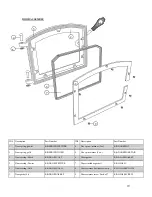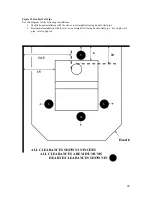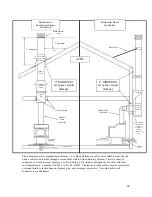
15
3.
Small hot fires produce less creosote than long, low smoldering fires. When you start your stove
or are re-kindling (reloading) your wood stove with a full or sizeable load of wood, open the draft
fully and burn the stove at full burn for 20-30 minutes to heat up the chimney and secondary burn
system. This ensures that when the draft control is pushed in for a lower, longer burn, the stove
will burn cleaner. You should notice more upper firebox flame activity. This is smoke from the
wood mixing with pre-heated air and burning. This is called secondary burn and results in higher
stove temperature at lower burn rates and less soot and creosote build-up. Just after starting the
fire, some smoke may occur until the chimney warms up to produce some draft. During normal
operation, adjust the draft to the position required. If properly set, it will assure longest burn times
and the most even heat cycle. Larger loads of wood will create the longest burn times.
Optional blower operation instructions
To install the blower, follow the instructions packaged with the blower. Plug the blower into the nearest
115V grounded circuit. Turn the variable speed knob to ‘click’ onto high speed. As the knob is turned
clock-wise, the blower speed decreases to your desired speed. The blower speed should match the desired
burn rate on your stove: i.e. low-burn rate...low blower speed; high-burn rate… high blower speed and so
forth.
Note: For a blower on pedestal models with outside air through the wall you will need an outside
air blower adapter. See your dealer.
Ash Pan Operating Instructions:
Safety Precautions
1. Do not operate your wood stove with the ash pan open or removed.
2. Empty the ash pan when the fire is at its lowest point or out.
3. NEVER empty ashes into a combustible container (paper bag,
plastic bucket, etc.)
4. NEVER leave ashes in the house or garage. Ashes that seem to be
cool may not be.
5. Check gasket on ash pan periodically to ensure a good seal.
Operation
1. Wait until the fire is at its lowest point or out.
2. Remove the ash pan by turning the handle and pulling out.
3. Take the ash pan outside and dump the ashes into a metal container.
4. Before replacing the ash pan, check to see if any ashes need to be removed from the ash pan
plenum. If any significant amount of ashes remain in the ash plenum, it will prevent the ash
pan from sliding all the way in and it may not seal, resulting in air entering the ash grate which
will produce a runaway fire.
5. Replace the ash pan by inserting it back into the stove, pushing in on the handle while in the
horizontal position, and turning to the straight up and down position (spring pointed down).
















































